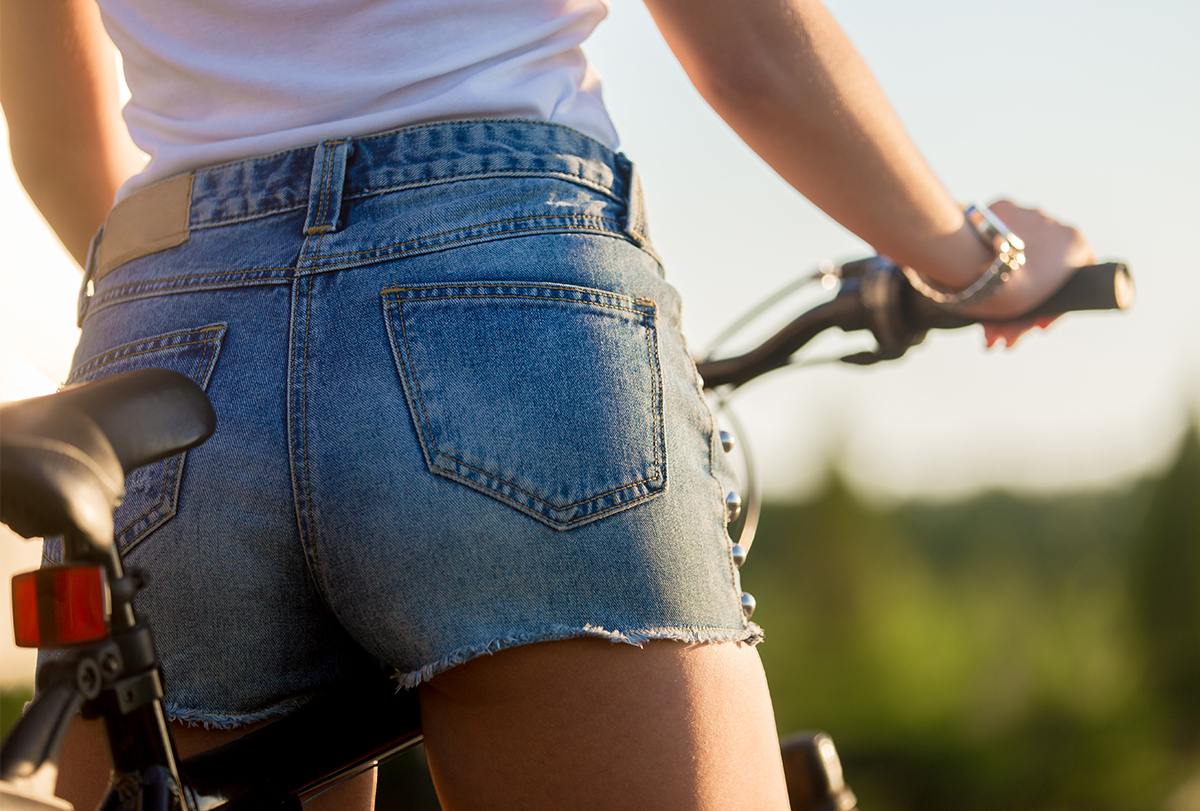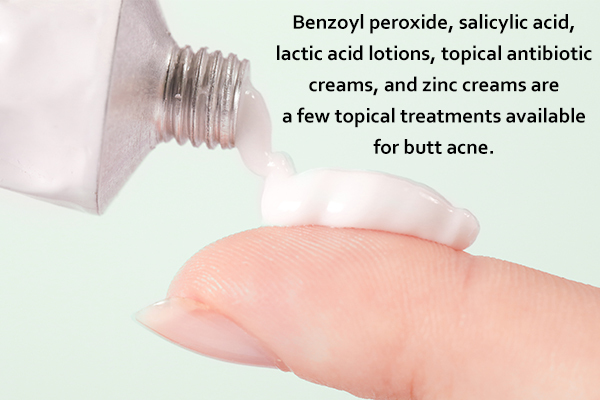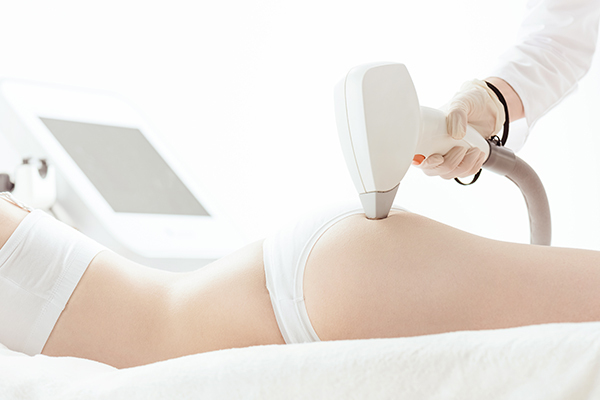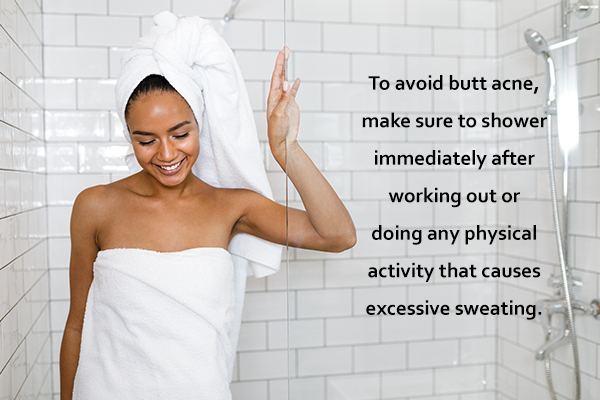In this article:
Butt acne is a relatively common but awkward situation to go through. Pimples on your butt (1) are usually a symptom of an underlying skin condition such as folliculitis (2) or keratosis pilaris. (3)

Folliculitis refers to an inflammation in the hair follicles usually caused by an infection. It leads to small pimples that sometimes itch or cause pain. It is one of the most common reasons for butt acne and can be treated with topical antibiotics. (4)(5)
Butt acne can affect anyone, although it tends to be more common among men. (5)
Read on to know more about the possible causes, treatments, and prevention methods for this condition.
Causes of Butt Acne
Here are some probable reasons for acne in the butt area:
Treatment Modalities for Butt Acne
Butt acne can be treated in a number of ways.
Oral agents
The following oral medications are usually prescribed for butt acne:
1. Retinoids
Sometimes, retinoids such as isotretinoin are prescribed to cure it. They can be prescribed for a couple of weeks or around a month, depending on the severity of your condition. (11)
Oral retinoids or topical retinoids can both be used, although oral retinoids are found to be much more effective. (12)(13)(14) However, retinoids should not be used in pregnant women or women trying to conceive as they can cause birth defects in the fetus. (15)
2. Broad-spectrum antibiotics
Minocycline, (16) tetracycline, (17) and doxycycline (18) are usually used in the treatment of butt acne.
3. Dapsone
Dapsone is another option for cases unresponsive to the above treatments.
Topical agents

These are a few topical treatments available for butt acne:
1. Benzoyl peroxide
Benzoyl peroxide is an over-the-counter product that helps cure acne due to its potent anti-inflammatory properties. (19)(20) It is especially useful in the treatment of inflammatory nodular acne.
Note: Benzoyl peroxide may cause skin irritation or dryness in some people. Discontinue use if you experience these side effects.
2. Salicylic acid
Salicylic acid helps to get rid of dead skin cells from the skin’s surface. They are available in the form of over-the-counter salicylic acid pads that can be applied on the skin along with benzoyl peroxide for maximum benefit. Do watch out for skin dryness (20)(21) and use a moisturizer.
3. Lactic acid lotions
Lactic acid helps get rid of debris, dead skin cells, and excess oil from the skin’s surface. This helps in the treatment of butt acne. Make sure to use a moisturizer along with it to avoid skin dryness. (21)
4. Topical antibiotic creams
Butt acne can be caused by bacterial growth in the hair follicles; thus, an antibiotic cream is usually recommended to treat it.
5. Zinc creams
Topical zinc has anti-inflammatory properties that help cure butt pimples. (20)(21)
Other therapies
These are a few clinical procedures that can be used to treat butt acne:
- Infrared light: Infrared light has been approved for use by the FDA in the treatment of acne. It promotes collagen production and helps get rid of the outer layer of skin cells to give you smoother skin. (22)
- Photodynamic therapy (PDT): Photodynamic therapy uses a solution that is applied to the skin and left to rest for 15 minutes to a couple of hours. Laser light is used to kill damaged cells on the outer layer of the skin, which in turn stimulates the production of new cells to take their place. (22)
- Photopneumatic therapy: Photopneumatic therapy involves the use of an intense pulsed light laser to remove excess oil and debris from the skin’s surface. (22)
- Drainage and extraction: Drainage of a cyst is done only in cases where it is not possible to cure it with medication. (23) It is a minor procedure in which a small cut is made in the skin and the contents of the cyst are drained. The cyst wall is removed and the skin is stitched up. The entire process is usually performed under local anesthesia.
- Intralesional steroid injections: Intralesional steroid injections are cortisol shots administered directly into a lesion or cyst to cure nodulocystic acne. (24) Triamcinolone acetonide solution is injected to provide rapid relief from a cyst in a couple of days. (25) This intervention is used only when absolutely necessary and must be administered by a dermatologist. Side effects can include a temporary sunken spot or lightening of the skin where the shot was administered.
Surgical interventions
The following surgical interventions are often used for removing HS lesions:
- Excision for HS treatment: Excision essentially means surgically removing the HS lesions, which can be done in one of two ways: (1) limited excision to cut off well-defined, localized lesions in mild to moderate HS or (2) wide excision, which involves a larger cut to remove more severe and spread-out HS lesions.
- Deroofing: Deroofing is a short, simple, minimally invasive surgical procedure that involves removing only the upper skin that covers the lesion, after which the open wound is left to heal on its own. This is a tissue-saving intervention that can only be performed in a clinical setting and is often used to treat mild to moderate HS lesions that are localized in a limited area such as the buttocks.
- Skin tissue-saving excision with electrosurgical peeling (STEEP): STEEP is an alternative to wide surgical excision. It helps save as much healthy skin tissue as possible, while getting rid of the diseased tissue with lesions. Although STEEP decreases healing time and has a better cosmetic outcome, HS recurrence is higher than that in surgical excision.
- Cryoinsufflation: Cryoinsufflation is used in the treatment of stage 1 or 2 HS. In this technique, liquid nitrogen is injected carefully into the sinus tracts that are present underneath the lesions. This process has to be repeated once a month until the tracts are destroyed due to freezing.
Treatment for Acne Scars

Resurfacing procedures are commonly performed by dermatologists to reduce acne scars and spots on the skin. Resurfacing refers to the removal of the outer, damaged layers of the skin to boost the production of new skin cells.
These are a few skin resurfacing options available nowadays:
- Laser skin resurfacing
- Chemical peeling
- Microdermabrasion
1. Laser resurfacing
Laser resurfacing or laser peeling is a non-invasive procedure that involves the use of a laser, most commonly Co2 laser or erbium:YAG laser. This instrument points a laser beam at the affected area to heat the layers underneath the skin and boost collagen production.
This procedure helps peel off the damaged outer layers of skin, making your skin smooth. (26)
2. Chemical peels
Chemical peels are commonly used by dermatologists to cure acne. They involve the use of gels, cream, or solutions that cause controlled peeling of the outer damaged layers of the skin, giving you smoother skin. At higher strengths, chemical peels can also treat acne scars. (26)
Trichloroacetic (TCA) peels are a type of chemical peel used to treat a wide range of skin concerns, including signs of aging, sun damage, hyperpigmentation, and scarring.
TCA peels are most commonly performed at medium strengths, which require some downtime, but offer significant improvements to the skin’s appearance.
TCA peels are used to get rid of acne spots and scars and help in the treatment of butt acne scars. (26)
3. Microdermabrasion
Microdermabrasion is a minimally invasive procedure. It is an exfoliating process that uses sand, aluminum oxide crystals, magnesium oxide, (baking soda) crystals, or even sodium chloride (salt) crystals to gently exfoliate the outer layers of the skin. It helps rejuvenate the skin and get rid of acne scars, fine lines, etc. (26)
4. Fillers
Dermal fillers can be used to cure skin depressions caused by acne scars. They help plump up the skin back to its normal state. Bellafill, which has a collagen base, has recently been FDA approved for use in the treatment of acne scars. (27)
Dermatologists can use fillers to treat some acne scar depressions in the skin. Fillers made from the patient’s own fat or prefilled HA fillers can be used to fill depressed scars. They can be temporary, lasting only for a few months, or permanent. (26)
Prevention and Management Strategies for Butt Acne

It is normal to get butt acne sometimes. However, you can reduce the chances of getting a breakout on your butt by observing these measures:
- Make sure to shower immediately after working out or doing any physical activity that causes excessive sweating.
- Avoid scrubbing your skin as this can irritate the hair follicles and cause butt acne. Exfoliate with alpha hydroxy acids for smooth skin.
- Avoid touching your pimples to prevent aggravating your acne and causing infections.
- Buy noncomedogenic or non-oily skin care products, such as body lotions and creams, to avoid bacterial infections due to clogging of skin pores and hair follicles.
- Use milk soap to shower or bathe as this helps prevent chemical irritation.
- Do not share your towels, napkins, etc., with anyone else. Make sure to use a clean towel every time you shower.
- Try not to use skin oils if you have chronic acne. Excess oil can cause clogged pores and hair follicles, leading to acne.
- Make sure to shower immediately after swimming or using public spas and hot tubs. This helps prevent chlorine irritation and skin infections.
- Make sure to eat a balanced diet filled with nutrients as your diet plays a major role in almost every aspect of your health.
Risk Factors for Butt Acne
There are a few risk factors for getting acne on your butt. Hereditary butt pimples are caused by a condition known as keratosis pilaris. It is most commonly observed during childhood or adolescence but may also occur in adults at times.
Risk factors for developing folliculitis include:
- Excessive weight gain
- Hormonal changes
- Genetic variations
- A history of diabetes
- Skin conditions such as acne, rosacea, or dermatitis
- Weak immune system
- Shaving or waxing the butt excessively
- Using dirty hot tubs or spas
- Using topical steroids
Potential Complications of Butt Acne
Butt acne is fairly harmless but can be an embarrassing situation, to say the least. However, some complications can occur in people suffering from folliculitis.
Touching or popping the pimples can lead to bacterial infections and boils. This may cause acne scars or even cysts.
When to See a Doctor

Consult a dermatologist if you suspect a bacterial infection is causing your acne. The dermatologist will evaluate the bumps and prescribe a treatment regimen to help cure your condition.
If your acne is a form of fungal folliculitis, necessary antifungal medications along with antibiotics will be prescribed to treat the lesions.
Contact a doctor immediately if:
- Your bumps are painful.
- Your butt acne keeps returning even after treatment.
- You do not see any improvement in your condition even after a couple of weeks.
- You have symptoms of an infection: fever, chills, nausea, pus oozing out of pimples, etc.
Most-Asked Questions About Butt Acne
What are the potential complications of butt acne?
Butt acne can lead to acne scars at times. Scarring is more likely to occur if you try to pop your pimples or squeeze them. This can also cause skin infections, which can lead to more acne and even boils.
Is it normal to get butt acne?
Butt acne can be an embarrassing condition to have but it is not unheard of. A lot of people suffer from pimples on the butt due to folliculitis (inflammation of the hair follicles) caused by shaving butt hair. It can also be caused by bacterial colonization in the hair follicles in summer.
Is laser treatment safe for butt acne?
Laser hair removal helps prevent ingrown hair that may occur when you try to shave your butt. You can also try over-the-counter salicylic acid to help prevent folliculitis or whiteheads on the butt. If nothing seems to work, consult your dermatologist for treatment.
Final Word
Butt acne is a rare but treatable condition. It can go away on its own, but some severe or chronic cases of butt acne may need medical evaluation. It usually occurs as a symptom of other conditions such as boils.
Consult a dermatologist to get yourself treated if you suffer from butt acne as there are no home remedies for this condition.
- Was this article helpful?
- YES, THANKS!NOT REALLY


